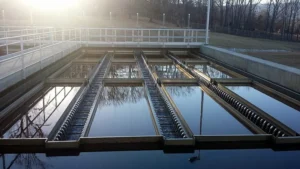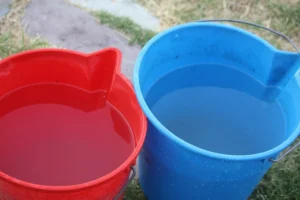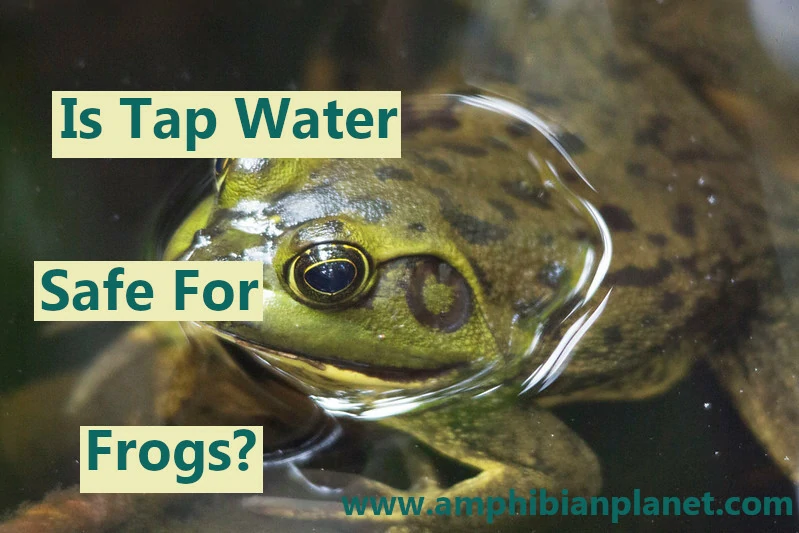Frogs have skin composed of thin membranous tissue that is quite permeable to water and contains a large network of blood vessels. They use this skin to breathe, and also to absorb water to rehydrate. Their skin does not just absorb oxygen and moisture though, many chemicals used in the treatment of tap water can also be absorbed.
Chlorine, chloramine, fluoride, and many other chemicals used in the treatment of tap water are toxic and harmful to frogs. For this reason, putting frogs in water straight from your tap can kill them, when the chemicals in the water are absorbed through their permable skin.
Fortunately, there are several ways to dechlorinate tap water and make it safe for frogs.
Also, other than tap water, there are many alternative water sources that will be completely safe for frogs (more information on that is below).
Tap Water Contains Harmful Chemicals
All of the water that comes into your home, whether it’s for your shower, toilet, kitchen sink, or outdoor faucet, is treated drinking water.
Local water companies get their water from lakes, rivers, and groundwater, which can be contaminated with germs, or substances that may be harmful to people.
Before the water reaches your tap, it passes through several treatment steps, to ensure it is safe for human consumption.

Public utility companies use different water treatment methods. However, there are a few common steps in water treatment used by nearly every utility company:
1. Coagulation – Chemicals such as specific types of salts, aluminum, or iron are added to the water. Dirt and other dissolved particles in the water bind with the chemicals to form slightly larger particles.
2. Flocculation – Following coagulation, the water is gently mixed, to form larger, heavier particles called ‘flocs’. Often, additional chemicals are added during this step to help the flocs form.
3. Sedimentation – The flocs are denser than water, so they drift to the bottom of the water treatment tank, settling in a removable layer.
4. Filtration – Once the flocs have settled to the bottom of the water, the clear water on top is passed through sand, gravel, or charcoal filters that take out dissolved particles, parasites, bacteria, viruses, and toxic chemicals. Activated carbon filters also remove any bad odors.
5. Disinfection – After the water has been filtered, one or more chemical disinfectants such as chlorine, chloramine, or chlorine dioxide, are added to kill any remaining germs.
Various other chemicals may be added to adjust pH levels or to prevent corrosion. Fluoride is also commonly added to reduce tooth decay.
To help keep water safe as it travels to homes, water treatment plants will make sure the water has low levels of chemical disinfectant when it leaves the treatment plant. This remaining disinfectant kills germs living in the pipes between the water treatment plant and your tap.
Since tap water contains chemical disinfectants such as chlorine, or chloramine, and additives such as fluoride, it is toxic to frogs. Placing frogs in the water straight from your tap can be lethal to them.
Frogs are very sensitive to substances in their water and require clean, unpolluted water in order to survive.
That said, there are a few ways to make tap water safe for frogs to live in and give them the best chance of a healthy life.
How to Make Tap Water Safe for Tadpoles
There are several methods you can use to dechlorinate tap water:
1. Use a Dechlorination Agent
The best and fastest way to make tap water safe for frogs is to use a dechlorination agent.
A good one for frogs is the Josh’s Frogs Dechlorinator Tap Water Conditioner (link to Amazon).
Follow the instructions on the bottle and add the required amount of dechlorination agent into the water. Doing this will remove harmful chlorine and chloramine from the tap water, making it safe for tadpoles to live in.
2. Let the Water Sit for a Few Days
An easy way to remove chlorine from tap water is to let it sit out in an open container for 1 – 5 days. At room temperature, chlorine gas weighs less than air and will naturally evaporate off.

To aid the process, you can aerate the water by stirring it from time to time. Doing this increases the rate of evaporation.
Even better, you could add an aquarium air pump or air stone, like those used in fish tanks, so the water is constantly getting aerated.
Another factor to consider is the surface area per volume of water. A wide-mouthed container will allow the chlorine to dissipate faster because it exposes more of the water’s surface to the air.
3. Boil the Water and Let It Cool
Another way to remove chlorine from water is to boil it in an open pot for 20 – 30 minutes and let it cool.
The boiling heat and the aeration created when boiling water will cause chlorine to evaporate from the water.
Raising the temperature increases the amount of chlorine that can evaporate in a given amount of time, so boiling it for 20 minutes or longer should remove a significant amount of the chlorine.
How effective this method will be is affected the the surface area of the water. If you boil a large pot of water, chlorine evaporates faster than when you boil water in a pot with a small narrow mouth.
Alternatives to Tap Water
Other than tap water, you can use water from several other sources to provide a safe environment for tadpoles to live in.
1. Well Water
In the wild, frogs are often found in shallow areas of lakes, ponds, rivers, creeks, and all of the natural sources of water, and since well water is drawn directly from the earth, frogs love well water, too.
Well water has been filtered naturally by the earth, and contains natural minerals which makes it a great source of water for tadpoles to live in.
Some wells may have been treated with a chlorine solution to kill bacteria and other microorganisms. In this case, you will need to dechlorinate the water before using it for frogs.
Also, sometimes well water can be slightly acidic, and may be very hard.
It’s a good idea to test your well water and adjust the pH and water hardness as needed.
The pH balance of water for frogs is best at a neutral 7.0. A pH of less than 6.5 or above 8.5 is not safe.
Well water may also not be properly oxygenated, but you can easily fix this with the use of an air pump or air stone, like those used in fish tanks.
2. Pond, Lake, and River Water
Water from ponds, rivers, lakes, and other bodies of water in your local area can be a great source of water for frogs.
However, this is a case-by-case basis, so not just any water will do.
If the frogs are from your local environment, getting water from a nearby pond will probably work. In fact, the frogs would most likely thrive if you released them into a local pond.
The most important thing here is to check the quality of the water in the pond and ensure it’s not polluted. If you see lots of other frogs or tadpoles, frogs living and thriving in the pond, the water is likely safe for your frogs.
However, if the frogs are from another location and are not adapted to your local environment, using pond water is not recommended.
Pond water often hosts waterborne pathogens, parasites, and bacteria. A native species may be able to handle those parasites because they are adapted to the environment.
A non-native species, on the other hand, could be vulnerable to the pathogens in the water.
3. Rainwater
Rainwater can be a great source of water for frogs, depending on how you obtain it.
If it recently rained in your area, you could go out and scoop up water from puddles on the ground. Just be mindful of the surrounding areas.

Do not collect any rainwater near a factory, chemical treatment plant, or any other industrial area as it could be polluted with harmful chemicals.
Also, many fertilizers, weed killers, and pesticides, used in farming can pollute rainwater, so be sure to avoid collecting any rainwater near farmland.
4. Bottled Water
Bottled water is generally safe for frogs, depending on the kind. Do NOT use water that is labeled as “distilled”.
Distilled water has had all of the beneficial minerals removed, so it causes more work for the frog’s kidneys. It may be used to replace water lost to evaporation, but tadpoles should not be kept in pure distilled water.

Bottled spring water will be a good source of water for frogs, as it is rich in naturally occurring and essential minerals like magnesium and calcium.
Water Not Recommended for Frogs
Frogs rely on the water they soak in and drink, to provide them with many of the minerals, and ions they need to carry out metabolic processes.
This is especially true for tadpoles, and aquatic frogs.
Distilled and reverse osmosis water contains none of the elements required by frogs and should not be used.
Distilled Water
Distilled water is water that has been treated in a water distiller.
During the distillation process, water is boiled until it vaporizes. This vapor condenses into a separate container.
All water, no matter no matter where it comes from – may have trace but
safe amounts of minerals, bacteria, and other contaminants.
Distilling rids the water of all those impurities. However, it also removes more than 99.9% of the minerals dissolved in water.
Frogs, especially tadpoles and aquatic frogs, require trace minerals and ions in their water to stay healthy, so they should never be kept in pure distilled water.
Reverse Osmosis Water
Reverse osmosis commonly referred to as RO, is a water purification technique where water is pushed under pressure through a semi-permeable reverse osmosis membrane.
Reverse osmosis removes 90 – 99.9% of contaminants, including minerals from the water.
Like distilled water, reverse osmosis water does not have the trace minerals and ions that frogs need in their water to stay healthy, so it should not be used as a source of water for frogs.
Featured image credit: Dennis Church (CC BY-NC-ND 2.0)
Sources:
McDaniel TV, Martin PA, Ross N, Brown S, Lesage S, Pauli BD. Effects of chlorinated solvents on four species of North American amphibians. Arch Environ Contam Toxicol. 2004 Jul;47(1):101-9. doi: 10.1007/s00244-004-3015-3. PMID: 15346783.
James T. Dayagbil II, Paul Karlo M. Dosdos, Galileo B. Roma III, Redem C. Deligero (2016). The effects of chlorine, detergent, and the mixture of both in mortality of toad embryo (Bufo marinus).
Goh EH, Neff AW.Effects of fluoride on Xenopus embryo development. Food Chem Toxicol. 2003 Nov;41(11):1501-8. doi: 10.1016/s0278-6915(03)00166-2. PMID: 12963002.


